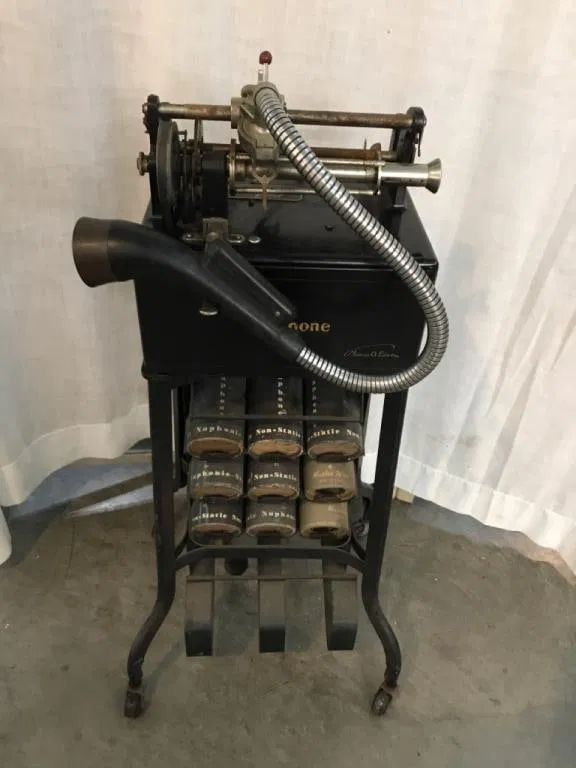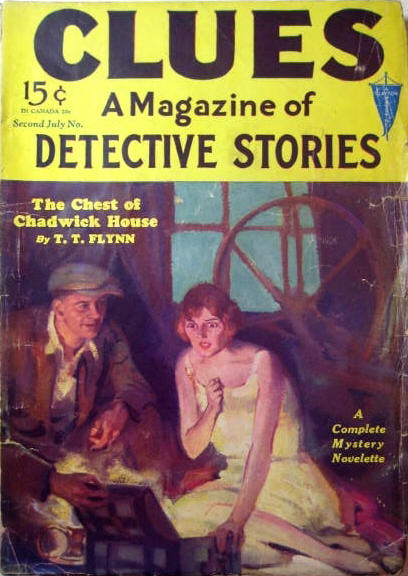This article on then Santa-Fe resident author T. T. Flynn appeared in a local newspaper in 1929.

Ted Flynn’s fiction factory has taken on new aspects of a prosperous growing industry with the addition of an Ediphone to Ted’s accessories for turning out quick copy to supply the demands of a string of some pulp magazines.
Flynn, whose office hours range from 1:00 till one, first wrote in longhand, then he used a typewriter stop the second medium proved too slow even with the assistance of stenographer-secretary, so Ted bought an electric typewriter. The electric typewriter was an improvement, but it likewise wasn’t quite fast enough to satisfy that nervous energy of Flynn’s. Now an Ediphone has been added to the electric typewriter and stenographer-secretary.

More remarkable than the Ediphone itself, is Flynn’s somewhat uncanny ability to visualize a story totally, and then dictate it straight through on records to be transcribed into manuscript by Tony Thoburn.
“Suppose you dictate something to the machine, and then decide that it isn’t what you want to say?” Flynn was asked. “What happens then?”
“I try to have each sentence thought through fully enough in advance,” Flynn replied, “so that I won’t have to make corrections. If I do decide to change a statement though, I make a break in the dictation, then repeat the portion of the paragraph I want to change and strike out the unwanted line after the manuscript has been transcribed.”
The advent of the Ediphone to Flynn’s studio fully justifies the term fiction factory.
A cheap method
Ediphone records cost the writer $0.60 each. Each one can be used 100 times, and the cost is $0.06 for each record dictated, transcribed and gotten ready for use again.
Into each record, Ted pours around 900 words, which represent 3 typewritten pages of 300 words to a page. He says a fair average is around 2700 words an hour.
Hard work
Flynn’s factory explodes old theories that the life of a successful writer is one of ease and comfort entirely. His working hours normally are longer than perhaps any other person in Santa Fe. Night-time hours attract him and it is the rule more than the exception that he can be found working until midnight and after, writing and dictating in one room while Tony transcribes, punctuates, and makes minor changes, preparing the manuscript for his final inspection. Some weeks the pulp artist turns out a story a day either upon order from some magazine or to be mailed to his New York agent who markets the copy.
No western stuff
Although Flynn has selected Santa Fe for his scene of operations and has been waiting here for nearly a year, he does not write western stuff. He experimented with one western railroad story which ran in one magazine as a serial. He has a tremendous range of vision and his yarns which range from love stories and monsters through the realm of adventure, war and aviation, are pictured from American cities, to the South sea islands, India, Malay and other foreign countries and islands.
One of his latest, written in the old Jack Thorpe home on the Camino, which Flynn bought some time ago, is an aviation thriller laid in Celebes.
His library
His library is composed entirely of source material and contains carefully selected books, purchased mostly in the United States and England, but of more interest than the books or the files of clippings and articles on every country and island in the world, and also clipped authentic material on subjects ranging from headhunters of South America to how to run a motorboat.
A mystery story
in addition to the stories of his own conception, flame is always prepared for the many orders which come from publishers for specific stories. Recently the magazine Clues, which buys a quantity of his copy, ordered a story to be titled The Chest of Chadwick House, which was needed to match the July cover of the magazine. The editor described the picture in a letter and Ted went to work developing the story. Later a proof sheet of the cover was sent.

In the picture a young man and young woman are kneeling before a small open chest in a dimly lighted attic the man appears to be intent upon something which was revealed when the lid to the chest was opened. The girl has a frightened look on her face.
The story of The Chest of Chadwick House was conceived from the editor’s description of the picture. The story has been written and sold and it will appear in the July issue of Clues.
Doesn’t plot stories
Flynn seldom plots a story fully in advance. More often he takes an idea, decides upon the beginning, and works out the story as he goes along. Sometimes orders come so thick and fast with from two weeks to 30 days notice, that Flynn’s fiction factory is in full day and night operation.
Such is the life of T. T. Flynn, Santa Fe’s pulp magazine production artist.